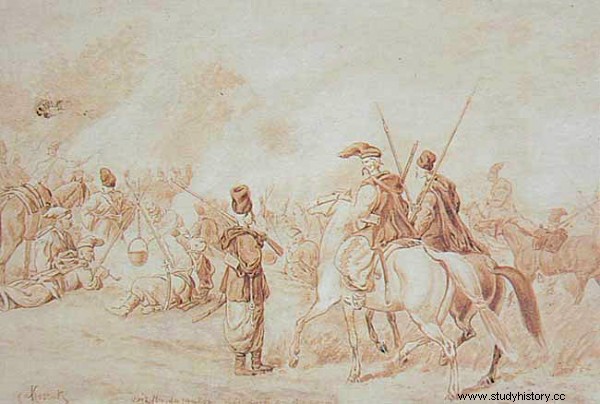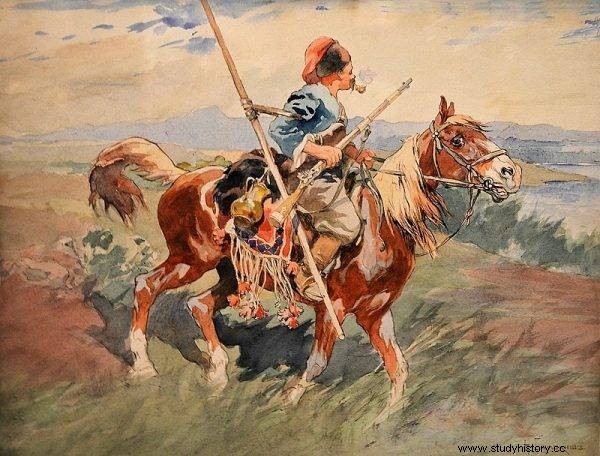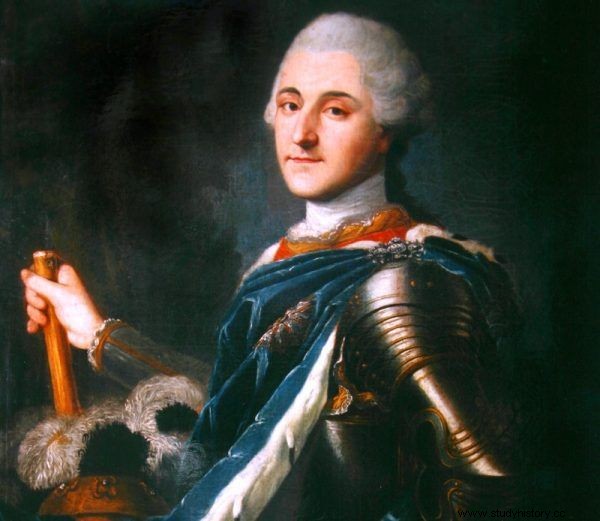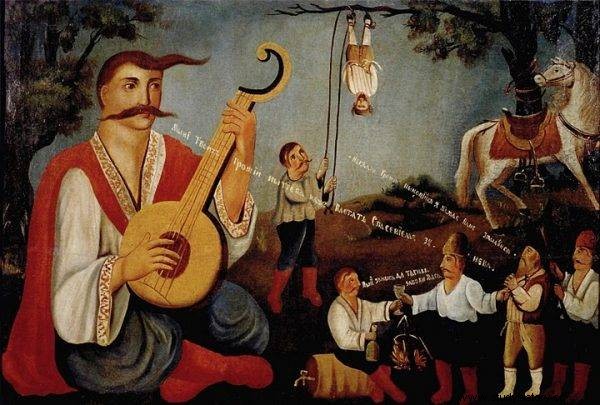An uprising against oppressive lords, the defense of the religion or the skilful movement of Russian propaganda? Why was there the slaughter of Poles and Jews in Ukraine in the 18th century?
It all started shortly after the establishment of the Bar Confederation. The first larger group of haidamaks was formed in Chłodny Jar near the Motronin Monastery (Melnyky village in Ukraine). The leader and the main agitator of the insurgent movement was Maksym Żeleźniak - Zaporizhzhia Cossack referring to the non-existent act of Tsarina Catherine II, known as the "Golden Hramota". The ruler allegedly ordered the expulsion of Polish nobility, Jews and Uniate priests from Ukraine.
Żeleźniak had no problems with gathering strength from the very beginning of the uprising. It was launched in the last days of May 1768. The angry mass of people was joined by Ruthenian peasants and Cossacks - all linked by an anti-feudal, national ideology that obviously led to aggression and bloodshed. Moreover, after the establishment of the Bar Confederation in Ukraine, tensions related to religious differences increased. The first victim of the enraged crowd was the town of Żabotyn, where the governor, the rabbi with his pregnant wife and a dozen Jews were killed . It is very likely that the local nobility also died. And that was just the beginning of the bloody Koliyivshchyna ...
March
Panic broke out at the news of the riots in the surrounding villages and small towns. People sought asylum mainly in cities where security was guaranteed by private magnate troops - most were sheltered in Uman and Biała Cerkiew. The alternative was to cross the Polish-Russian border, and for the Uniate clergy - an express change of religion. The collective panic ensured the relatively bloodless course of the first stage of the uprising. The Haidamaks were mainly engaged in looting abandoned goods, crops and livestock. The ... traces of the previous administration were handled particularly brutally:official documents were destroyed, manors were demolished, and forests belonging to the nobility were even cut down.

Haidamak camp
The carefree demolition attracted so many followers that the leaders of the uprising decided to separate their forces. Three separate divisions were created that moved towards Cherkassy, Korsun and Fastov. The commander of one of the groups, Żeleźniak, after the trouble-free capture of Cherkassy and passing through Korsuń, gave up the attack on the Biała Cerkiew due to the well-equipped defensive troops stationed there. Instead, headed towards Łysianka, where several hundred people of noble origin and Jews hid in a fortified castle .
The insurgents took the castle as a trick:a delegation of Ruthenian peasants persuaded voivode Kuczewski to give up the fortifications in exchange for his life and personal property. The defender agreed to the offer and opened the gate. Then several hundred insurgents stormed inside ...
Pole, Jew and Dog
The haidamak hatred, constantly fueled by the haidamaks, could finally find an outlet. Kuczewski was caught and saddled, and then he was ordered to carry the executioners on his back. When he exhausted himself, he was stabbed with pikes. It was the spades that were the favorite weapon of the haidamaks and it is believed that they may have been the source of the colloquial name of the uprising:Koliyivshchyna - from the words "Koli! Koli! " signifying stinging. Behind the walls of the castle, a row of protruding blades was set up and helpless victims were dropped on them - including people sheltering in panic on the roofs. As Władysław Serczyk writes:
The slaughter took place in all castle rooms. Only a few people survived. (...) In the nearby wooden church of oo. of the Franciscans, a monk, a Jew and a dog were hung on one beam, affixing the inscription: "Lach, Jew and Sobaka, wse whirl badge" .

photo:Mykola Samokysh / public domain The constantly fueled hatred of the haidamaks could finally find an outlet.
The inscription (translated as:"A Pole, a Jew and a dog are one faith") appeared later wherever the insurgent forces moved. He was so deeply engraved in historical memory that it was used in the songs of the Organization of Ukrainian Nationalists back in the 1930s. When Żeleźniak's haidamaks were hanging more Poles and Jews, they also killed a dog.
The slaughter in Uman
After the conquest of Czerkasy and Żabotyn, Smila, Korsun, Bohusław and Łysianka, Żeleźniak headed to Uman. The private town of Franciszek Salezy Potocki became a place of refuge for thousands of people. And most likely would have been an effective refuge were it not for Ivan Gonta's betrayal , a centurion of the Cossack court militia. The Russian part of the Humania community helped the haidamaks to capture the city. There was the most terrible massacre of the uprising, during which several thousand people died.
Ivan Gonta was sent to the city's defense commander, administrator Rafał Despot Mładanowicz, as a mediator. However, he turned away from his superior and helped the rebels overcome the walls of Uman. In return, when the slaughter was over, he proclaimed himself Prince of Humans. Meanwhile, Żeleźniak named himself the main leader of Koliyivshchyna, the Duke of Smil and the Cossack Hetman.
Haidamakas spared no one. They set fire to churches and murdered people escaping from them. Jews had their limbs and parts of the face cut off. As well as others died Uniate and Catholic priests, and even religious from the local Basilian monastery . Estimates of the number of victims of the massacre vary and range from two to twenty thousand people.
A bit of exaggeration
Żeleźniak's successes incited the peasants to such an extent that at one point the rebels controlled territories from Chernobyl in the north to the Baltic Sea in the south. Fights broke out in Wołyń, Podolia, Polesie and Lithuania, as well as in the Left-Bank Ukraine. The turning point was the attack on the town of Palejowe Jezioro bordering Turkey, and then the haidamak invasion of Turkey and the attack of Bałta and Gołta.

The forces under the command of Mikhail Krechetnikov and the royal troops of Stanisław August began to repress the peasantry.
The reaction from Turkey - initiating a war with Russia - led to the decision to suppress the uprising. The forces under the command of Mikhail Kreczetnikov and the royal troops of Stanisław August began to repress the peasantry. The leaders of Koliyivshchyna were quickly captured:Gonta was executed after torture, and Żeleźniak was handed over to the Russian judiciary. He was sent to Siberia. It took the cavalry several months to kill the peasant militias. The insurgents were murdered so fiercely that in the end the nobility themselves had to ask for at least part of the workforce to be left alive. Józef Stempkowski, a horse-footed horse from Kodeń near Żytomierz, contributed especially to suppressing the rebellion, who led to the execution of several thousand peasants.
Where does this aggression come from?
In total, during the Koliyivshchyna, one hundred to two hundred thousand people was murdered - mainly Poles and Jews - on the territory of Right-Bank Ukraine. There are a number of conjectures about the underlying causes of the uprising. Some historians blame Russia's propaganda activity, which uses religion and the artificial division into Russian and Polish peasants, while others look for causes in the mentality of the Ruthenian population, which showed a tendency to bloody rebellions. Tadeusz Srogosz writes:
Many Ukrainian historians have written about Koliyivshchyna. Ukrainian and Russian historians, both in the nineteenth century and in the twentieth century, similarly described the events of the haidamak movement and Koliyivshchyna. They generally reject the thesis that Russia provoked Koliyivshchyna and point to its religious, ethnic and social background. strong> It was supposed to be a revolt of the Orthodox peasants against the Catholic Polish nobility . (...) sometimes the favorable conditions are mentioned, i.e. the Bar Confederation and the dissident cause. The haidamak tradition, a continuation of the Cossack tradition, was to shape the awareness of the Ukrainian popular masses .

In total, from one hundred to two hundred thousand people were murdered during the Koliyivshchyna - mainly Poles and Jews
Interestingly, everything indicates that there was no actual oppression by "Polish lords" in the areas covered by the uprising . Not only that:nature gave the local people abundantly. In the past, it was even claimed that the peasant rebellion could have taken place due to too much freedom and religious antagonism. Such opinions, however, are criticized by younger historians who blame Żeleźniak's activity on "defending the Orthodox Church" and do not resort to explaining people's behavior with inborn malice towards authority and order. This, of course, does not change the fact that Russia started to suppress the uprising only when it started to cause trouble, and the haidamaks tried on the eastern side were practically unpunished.
Bibliography:
- Głowacki, J., J., Attitude of the Bar Confederation to Protestants . Acta Universitatis Lodziensis, Folia Historica 90, 2013.
- Serczyk, W., A., Koliszczyzna. Krakow, 1968.
- Serczyk, W., A., A slaughter in which several thousand nobility, Jews and Uniate priests died. History of Ukraine, Wyd. III, Wroclaw-Warsaw-Krakow, 2001.
- Srogosz, T., Koliszczyzna in Ukrainian historiography and current history textbooks. Polish-Ukrainian Yearbook 2014, vol. XVI. Scientific Works of the Academy of Jan Długosz in Częstochowa.
